HYDRUS-1D Simulation of Nitrogen Dynamics in Rainfed Sweet Corn Production
Abstract
1. Introduction
2. Material and Methods
2.1. Field Experiments and Measurements
2.1.1. Site Description
2.1.2. Experimental Design
2.1.3. Measurements
2.2. HYDRUS-ID Model
2.2.1. Model Description
2.2.2. Solute Transport and Reaction Parameters
2.2.3. Initial and Boundary Conditions
2.2.4. Root Distribution and N Uptake
2.2.5. Model Evaluation
3. Results and Discussion
3.1. Model Calibration and Validation
3.2. Nitrogen Concentrations in the Soil Profile
3.3. Crop Nitrogen Uptake
3.4. Nitrogen Loss Due to Surface Runoff
3.5. Nitrogen Leaching
4. Conclusions
Author Contributions
Funding
Acknowledgments
Conflicts of Interest
References
- Chandna, P.; Khurana, M.; Ladha, J.K.; Punia, M.; Mehla, R.; Gupta, R. Spatial and seasonal distribution of nitrate-N in groundwater beneath the rice–wheat cropping system of India: A geospatial analysis. Environ. Monit. Assess. 2011, 178, 545–562. [Google Scholar] [CrossRef] [PubMed]
- Becker, M.; Asch, F.; Maskey, S.; Pande, K.; Shah, S.; Shrestha, S. Effects of transition season management on soil N dynamics and system N balances in rice–wheat rotations of Nepal. Field Crop Res. 2007, 103, 98–108. [Google Scholar] [CrossRef]
- Wienhold, B.J.; Trooien, T.P.; Reichman, G.A. Yield and nitrogen use efficiency of irrigated corn in the northern Great Plains. Agron. J. 1995, 87, 842–846. [Google Scholar] [CrossRef]
- Wei, Y.; Chen, D.; Hu, K.; Willett, I.R.; Langford, J. Policy incentives for reducing nitrate leaching from intensive agriculture in desert oases of Alxa, Inner Mongolia, China. Agric. Water Manag. 2009, 96, 1114–1119. [Google Scholar] [CrossRef]
- Karandish, F.; Darzi-Naftchali, A.; Asgari, A. Application of machine-learning models for diagnosing health hazard of nitrate toxicity in shallow aquifers. Paddy Water Environ. 2017, 15, 201–215. [Google Scholar] [CrossRef]
- Zhu, J.; Li, X.; Christie, P.; Li, J. Environmental implications of low nitrogen use efficiency in excessively fertilized hot pepper (Capsicum frutescens L.) cropping systems. Agric. Ecosyst. Environ. 2005, 111, 70–80. [Google Scholar] [CrossRef]
- Tamini, T.; Mermoud, A. Water and nitrate dynamics under irrigated onion in a semi-arid area. Irrig. Drain. J. Int. Comm. Irrig. Drain. 2002, 51, 77–86. [Google Scholar] [CrossRef]
- McGrath, G.; Hinz, C.; Sivapalan, M. Assessing the impact of regional rainfall variability on rapid pesticide leaching potential. J. Contam. Hydrol. 2010, 113, 56–65. [Google Scholar] [CrossRef] [PubMed]
- Wang, H.; Ju, X.; Wei, Y.; Li, B.; Zhao, L.; Hu, K. Simulation of bromide and nitrate leaching under heavy rainfall and high-intensity irrigation rates in North China Plain. Agric. Water Manag. 2010, 97, 1646–1654. [Google Scholar] [CrossRef]
- Santos, D.V.; Sousa, P.L.; Smith, R.E. Model simulation of water and nitrate movement in a level-basin under fertigation treatments. Agric. Water Manag. 1997, 32, 293–306. [Google Scholar] [CrossRef]
- Šimůnek, J.; van Genuchten, M.T.; Šejna, M. Development and Applications of the HYDRUS and STANMOD Software Packages and Related Codes. Vadose Zone J. 2008, 7, 587–600. [Google Scholar] [CrossRef]
- Li, Y.; Šimůnek, J.; Zhang, Z.; Jing, L.; Ni, L. Evaluation of nitrogen balance in a direct-seeded-rice field experiment using Hydrus-1D. Agric. Water Manag. 2015, 148, 213–222. [Google Scholar] [CrossRef]
- Karandish, F.; Šimůnek, J. Two-dimensional modeling of nitrogen and water dynamics for various N-managed water-saving irrigation strategies using HYDRUS. Agric. Water Manag. 2017, 193, 174–190. [Google Scholar] [CrossRef]
- He, K.; Yang, Y.; Yang, Y.; Chen, S.; Hu, Q.; Liu, X.; Gao, F. HYDRUS simulation of sustainable brackish water irrigation in a winter wheat-summer maize rotation system in the North China Plain. Water 2017, 9, 536. [Google Scholar] [CrossRef]
- Ren, D.; Xu, X.; Hao, Y.; Huang, G. Modeling and assessing field irrigation water use in a canal system of Hetao, upper Yellow River basin: Application to maize, sunflower and watermelon. J. Hydrol. 2016, 532, 122–139. [Google Scholar] [CrossRef]
- Li, Y.; Šimůnek, J.; Jing, L.; Zhang, Z.; Ni, L. Evaluation of water movement and water losses in a direct-seeded-rice field experiment using Hydrus-1D. Agric. Water Manag. 2014, 142, 38–46. [Google Scholar] [CrossRef]
- Gabiri, G.; Burghof, S.; Diekkrüger, B.; Leemhuis, C.; Steinbach, S.; Näschen, K. Modeling spatial soilwater dynamics in a tropical floodplain, East Africa. Water 2018, 10, 191. [Google Scholar] [CrossRef]
- Silva Ursulino, B.; Maria Gico Lima Montenegro, S.; Paiva Coutinho, A.; Hugo Rabelo Coelho, V.; Cezar dos Santos Araújo, D.; Cláudia Villar Gusmão, A.; Martins dos Santos Neto, S.; Lassabatere, L.; Angulo-Jaramillo, R. Modelling soil water dynamics from soil hydraulic parameters estimated by an alternative method in a tropical experimental basin. Water 2019, 11, 1007. [Google Scholar] [CrossRef]
- Martello, M.; Dal Ferro, N.; Bortolini, L.; Morari, F. Effect of incident rainfall redistribution by maize canopy on soil moisture at the crop row scale. Water 2015, 7, 2254–2271. [Google Scholar] [CrossRef]
- Hou, L.; Zhou, Y.; Bao, H.; Wenninger, J. Simulation of maize (Zea mays L.) water use with the HYDRUS-1D model in the semi-arid Hailiutu River catchment, Northwest China. Hydrol. Sci. J. 2017, 62, 93–103. [Google Scholar]
- Negm, A.; Capodici, F.; Ciraolo, G.; Maltese, A.; Provenzano, G.; Rallo, G. Assessing the Performance of Thermal Inertia and Hydrus Models to Estimate Surface Soil Water Content. Appl. Sci. 2017, 7, 975. [Google Scholar] [CrossRef]
- Ramos, T.; Šimunek, J.; Gonçalves, M.; Martins, J.; Prazeres, A.; Castanheira, N.L.; Pereira, L.S. Field evaluation of a multicomponent solute transport model in soils irrigated with saline waters. J. Hydrol. 2011, 407, 129–144. [Google Scholar] [CrossRef]
- Ramos, T.B.; Darouich, H.; Šimůnek, J.; Gonçalves, M.C.; Martins, J.C. Soil salinization in very high-density olive orchards grown in southern Portugal: Current risks and possible trends. Agric. Water Manag. 2019, 217, 265–281. [Google Scholar] [CrossRef]
- Allen, R.G.; Pereira, L.S.; Raes, D.; Smith, M. FAO Irrigation and Drainage Paper No. 56. Crop Evapotranspiration (guidelines for computing crop water requirements). Irrig. Drain. 1998, 300, 300. [Google Scholar]
- Brouwer, C.; Heibloem, M. Irrigation Water Management: Irrigation Water Needs Training Manual; Food and Agriculture Organization: Rome, Italy, 1986; Volume 3, Available online: http://www.fao.org/tempref/agl/AGLW/fwm/Manual3.pdf (accessed on 14 March 2001).
- Ali, M. Pollution of water resources from agricultural fields and its control. In Practices of Irrigation & On-Farm Water Management: Volume 2; Springer: New York, NY, USA, 2011; pp. 241–269. [Google Scholar]
- Hanson, B.R.; Šimůnek, J.; Hopmans, J.W. Evaluation of urea-ammonium-nitrate fertigation with drip irrigation using numerical modeling. Agric. Water Manag. 2006, 86, 102–113. [Google Scholar] [CrossRef]
- Selim, H.; Iskandar, I. Modeling nitrogen transport and transformations in soils: 1. Theoretical considerations 1. Soil Sci. 1981, 131, 233–241. [Google Scholar] [CrossRef]
- Lotse, E.; Jabro, J.; Simmons, K.; Baker, D. Simulation of nitrogen dynamics and leaching from arable soils. J. Contam. Hydrol. 1992, 10, 183–196. [Google Scholar] [CrossRef]
- Zhou, S.-L.; Wu, Y.-C.; Wang, Z.-M.; Lu, L.-Q.; Wang, R.-Z. The nitrate leached below maize root zone is available for deep-rooted wheat in winter wheat–summer maize rotation in the North China Plain. Environ. Pollut. 2008, 152, 723–730. [Google Scholar] [CrossRef]
- Chen, B.; Liu, E.; Mei, X.; Yan, C.; Garré, S. Modelling soil water dynamic in rain-fed spring maize field with plastic mulching. Agric. Water Manag. 2018, 198, 19–27. [Google Scholar] [CrossRef]
- Iqbal, M.; Kamal, M.R.; Che Man, H.; Wayayok, A. HYDRUS-1D Simulation of Soil Water Dynamics for Sweet Corn under Tropical Rainfed Condition. Appl. Sci. 2020, 10, 1219. [Google Scholar] [CrossRef]
- Mo’allim, A.; Kamal, M.; Muhammed, H.; Mohd Soom, M.; Mohamed Zawawi, M.; Wayayok, A.; Che Man, H. Assessment of Nutrient Leaching in Flooded Paddy Rice Field Experiment Using Hydrus-1D. Water 2018, 10, 785. [Google Scholar] [CrossRef]
- Hu, K.; Li, B.; Chen, D.; Zhang, Y.; Edis, R. Simulation of nitrate leaching under irrigated maize on sandy soil in desert oasis in Inner Mongolia, China. Agric. Water Manag. 2008, 95, 1180–1188. [Google Scholar] [CrossRef]
- He, Y.; Lehndorff, E.; Amelung, W.; Wassmann, R.; Alberto, M.C.; von Unold, G.; Siemens, J. Drainage and leaching losses of nitrogen and dissolved organic carbon after introducing maize into a continuous paddy-rice crop rotation. Agric. Ecosyst. Environ. 2017, 249, 91–100. [Google Scholar] [CrossRef]
- Fuhrmann, I.; He, Y.; Lehndorff, E.; Brüggemann, N.; Amelung, W.; Wassmann, R.; Siemens, J. Nitrogen fertilizer fate after introducing maize and upland-rice into continuous paddy rice cropping systems. Agric. Ecosyst. Environ. 2018, 258, 162–171. [Google Scholar] [CrossRef]
- Caiqiong, Y.; Jun, F. Application of HYDRUS-1D model to provide antecedent soil water contents for analysis of runoff and soil erosion from a slope on the Loess Plateau. Catena 2016, 139, 1–8. [Google Scholar] [CrossRef]
- Wu, J.; Ding, J.; Lu, J. Nitrate Transport Characteristics in the Soil and Groundwater. Procedia Eng. 2016, 157, 246–254. [Google Scholar] [CrossRef]
- Tafteh, A.; Sepaskhah, A.R. Application of HYDRUS-1D model for simulating water and nitrate leaching from continuous and alternate furrow irrigated rapeseed and maize fields. Agric. Water Manag. 2012, 113, 19–29. [Google Scholar] [CrossRef]


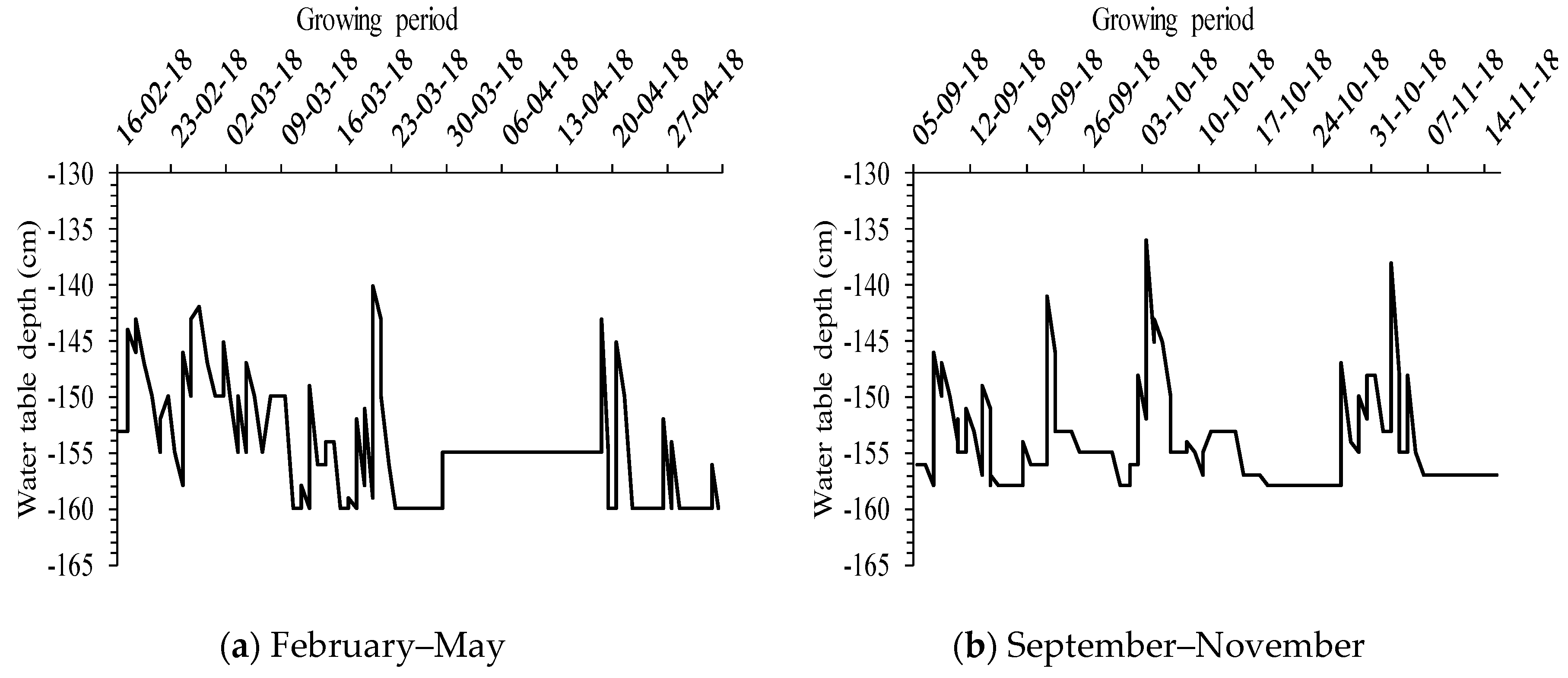
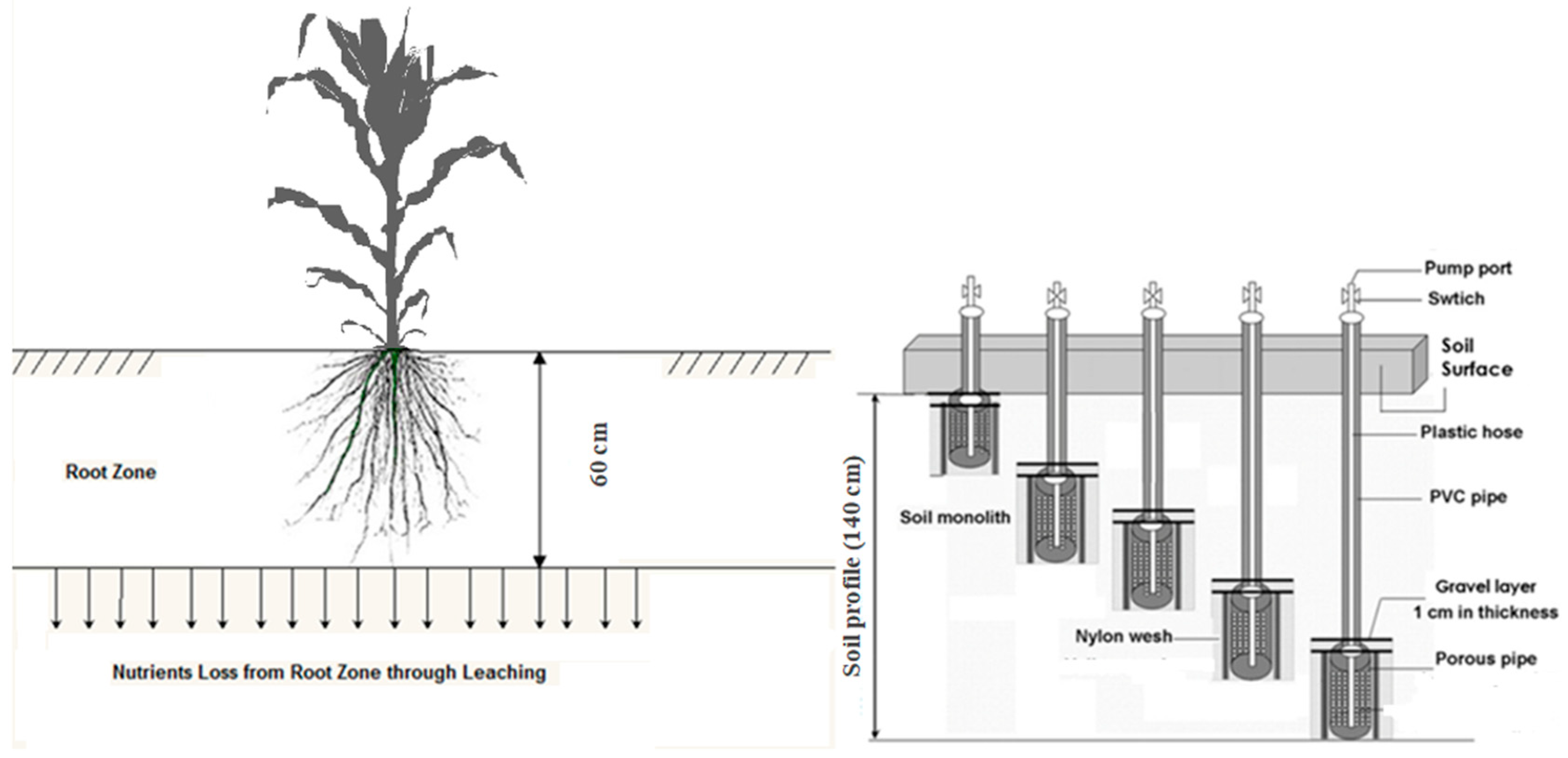
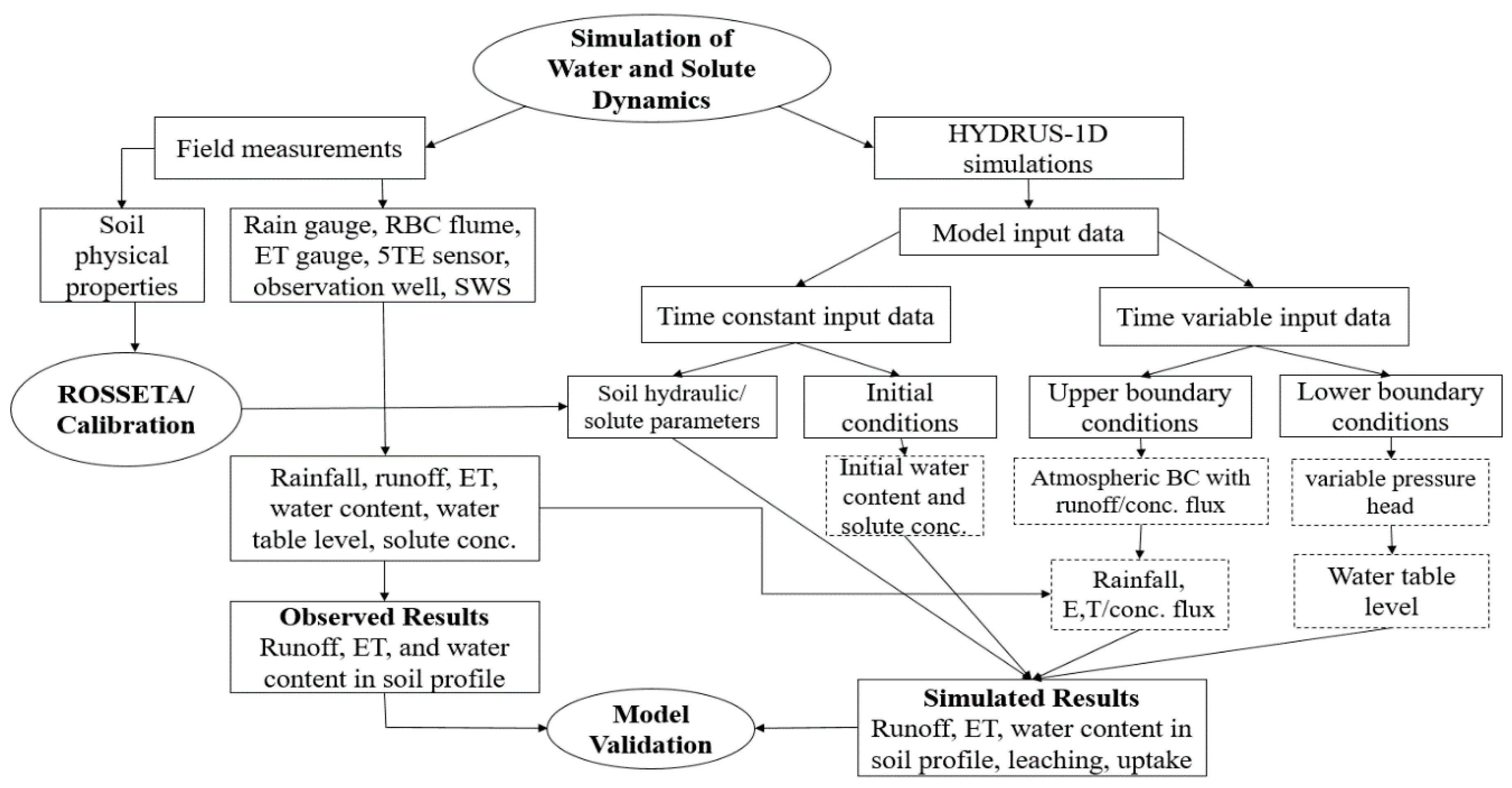


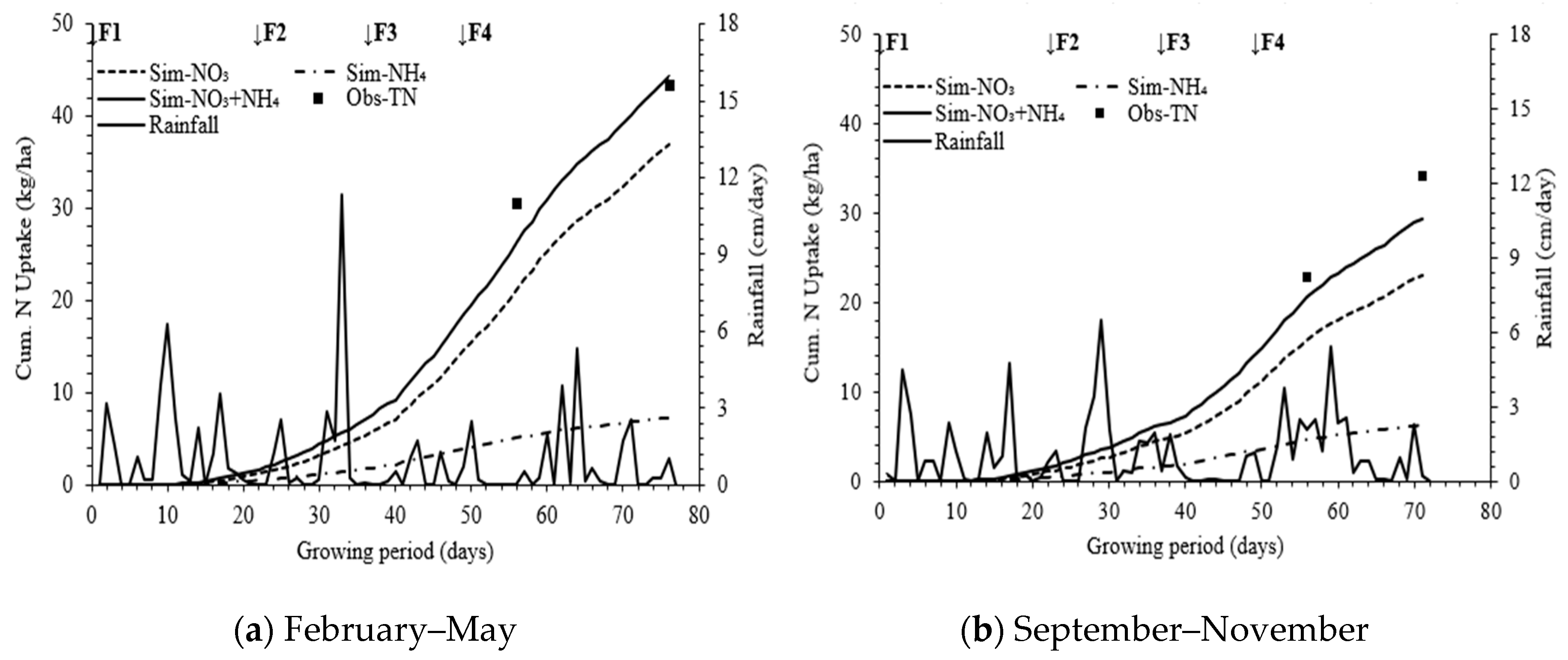
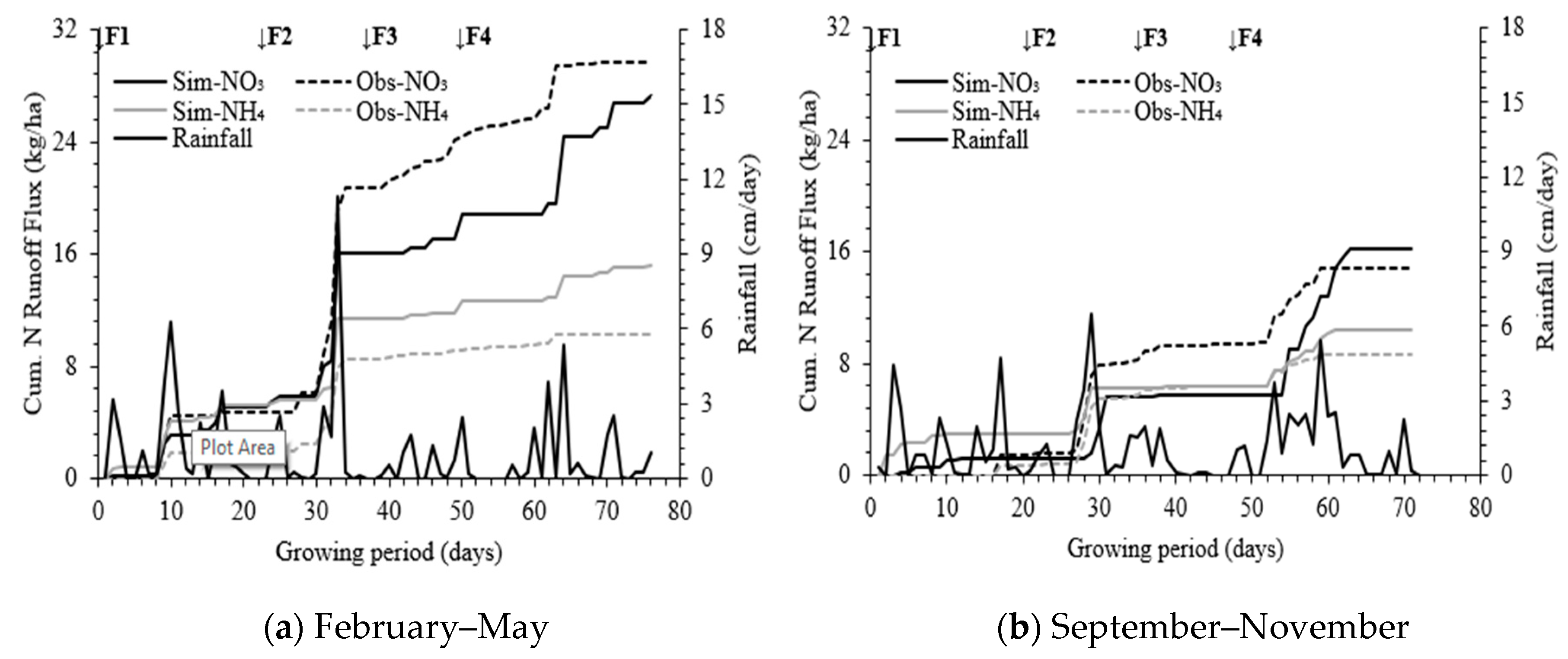
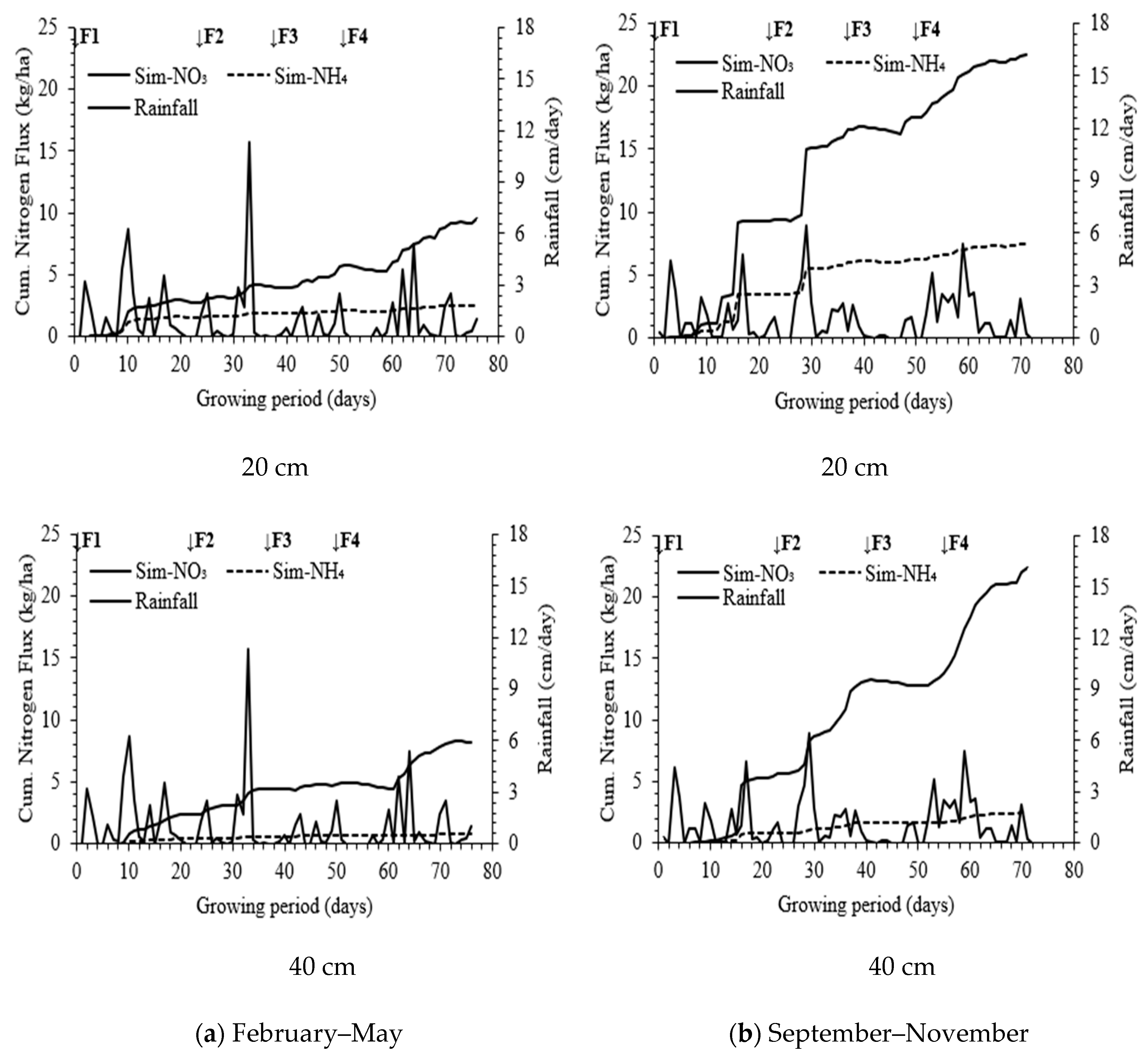
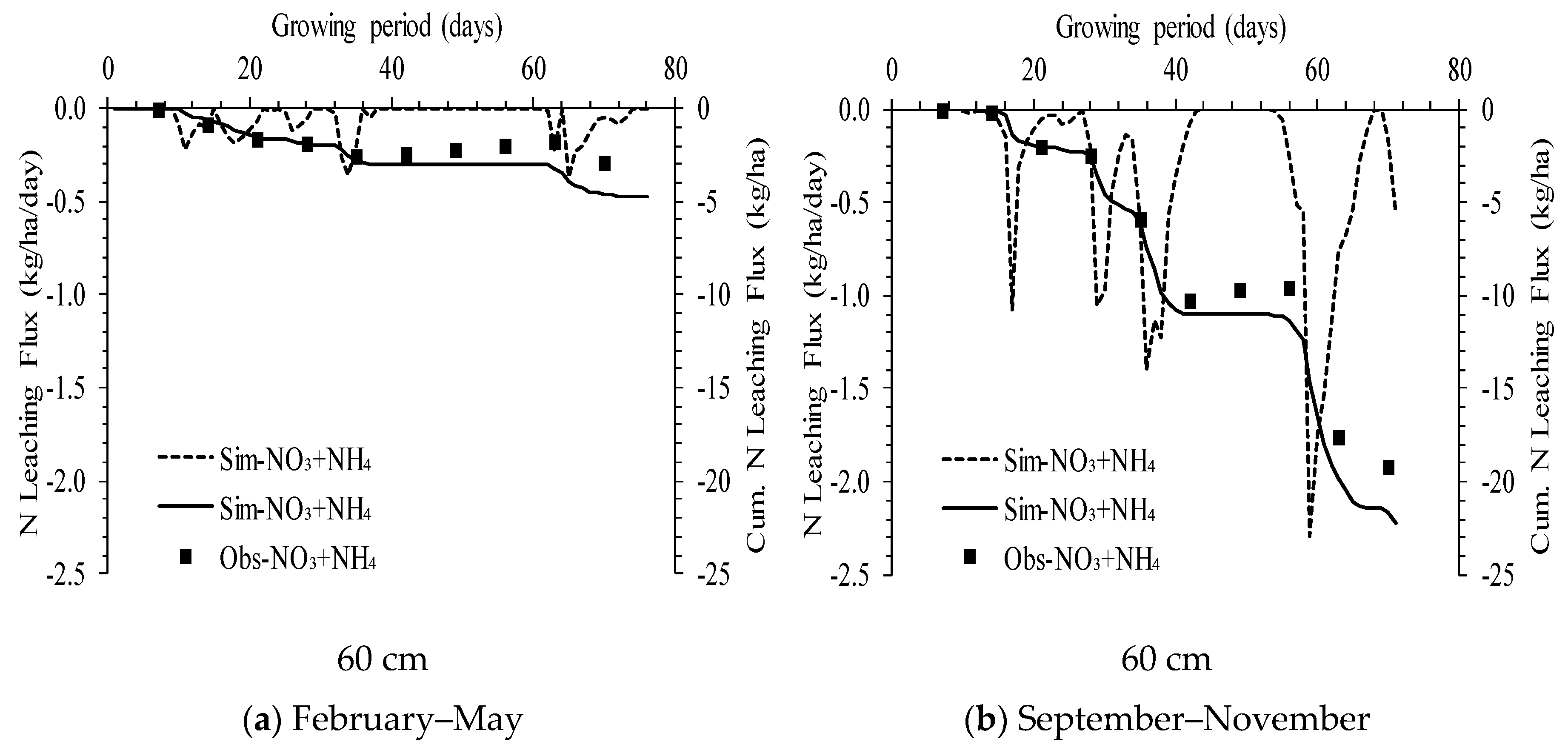
| Depth (cm) | Clay % | Silt % | Sand % | Textural Class | Bulk Density (g cm−3) | Conductivity Ks (cm d−1) |
|---|---|---|---|---|---|---|
| 0–20 | 65.36 | 9.79 | 24.84 | Clay | 1.36 | 12.86 |
| 20–40 | 53.28 | 15.24 | 31.45 | Clay | 1.39 | 12.43 |
| 40–60 | 58.66 | 13.12 | 28.23 | Clay | 1.31 | 12.78 |
| 60–80 | 70.20 | 20.22 | 09.58 | Clay | 1.22 | 18.11 |
| 80–140 | 71.74 | 18.03 | 10.23 | Clay | 1.24 | 17.56 |
| First Season (2018) | Second Season (2018) | Agricultural Activities |
|---|---|---|
| 16 February | 5 September | Basal fertilizer application (60 kg N·ha−1) NPK 15:15:15; Sowing of sweet corn (10 kg of seed·ha−1) |
| 10 March | 26 September | Second fertilizer application (25 kg N·ha−1) |
| 24 March | 10 October | Third fertilizer application (25 kg N·ha−1) |
| 5 April | 21 October | Fourth fertilizer application (10 kg N·ha−1) |
| 3 May | 15 November | Harvesting |
| Season | Solute | R2 | RMSE (mg·L−1) |
|---|---|---|---|
| 1 | NO3−-N | 0.99 | 0.62 |
| NH4+-N | 0.97 | 0.26 | |
| 2 | NO3−-N | 0.99 | 0.46 |
| NH4+-N | 0.95 | 0.28 |
© 2020 by the authors. Licensee MDPI, Basel, Switzerland. This article is an open access article distributed under the terms and conditions of the Creative Commons Attribution (CC BY) license (http://creativecommons.org/licenses/by/4.0/).
Share and Cite
Iqbal, M.; Kamal, M.R.; Mohd Soom, M.A.; Yamin, M.; Fazly M., M.; Che Man, H.; Muhammed, H.H. HYDRUS-1D Simulation of Nitrogen Dynamics in Rainfed Sweet Corn Production. Appl. Sci. 2020, 10, 3925. https://doi.org/10.3390/app10113925
Iqbal M, Kamal MR, Mohd Soom MA, Yamin M, Fazly M. M, Che Man H, Muhammed HH. HYDRUS-1D Simulation of Nitrogen Dynamics in Rainfed Sweet Corn Production. Applied Sciences. 2020; 10(11):3925. https://doi.org/10.3390/app10113925
Chicago/Turabian StyleIqbal, Mazhar, Md Rowshon Kamal, Mohd Amin Mohd Soom, Muhammad Yamin, Mohd Fazly M., Hasfalina Che Man, and Hadi Hamaaziz Muhammed. 2020. "HYDRUS-1D Simulation of Nitrogen Dynamics in Rainfed Sweet Corn Production" Applied Sciences 10, no. 11: 3925. https://doi.org/10.3390/app10113925
APA StyleIqbal, M., Kamal, M. R., Mohd Soom, M. A., Yamin, M., Fazly M., M., Che Man, H., & Muhammed, H. H. (2020). HYDRUS-1D Simulation of Nitrogen Dynamics in Rainfed Sweet Corn Production. Applied Sciences, 10(11), 3925. https://doi.org/10.3390/app10113925






